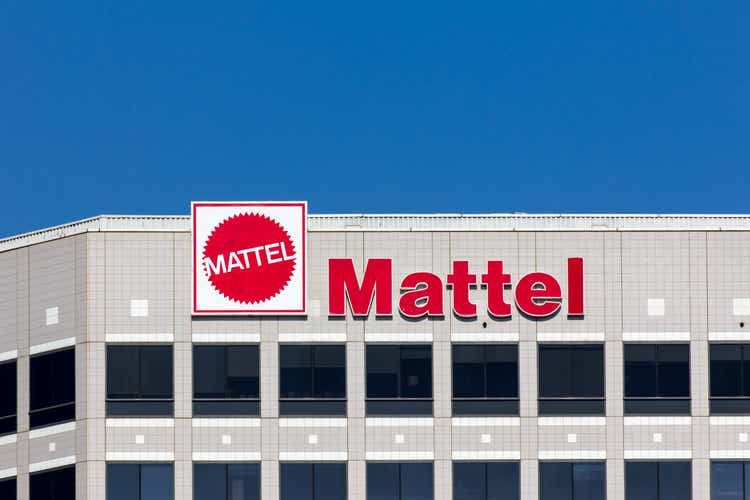Wolterk
Many toy manufacturers are trading near their lows, including a well-established name like Mattel, Inc. (NASDAQ:MAT). The truth of the matter is that I have not covered Mattel for quite a while, in fact, it was a decade ago when I concluded that Barbie triggered a selloff back in 2012.
This, of course, came after the company came out of the recession from a few years ago. Shares actually traded around the $30 mark at the time, giving the company a $10.5 billion equity valuation at the time, equal to 1.7 times sales (of around $6 billion) and 13.5 times earnings, while committing to a compelling 4% dividend yield.
After deciding that I saw no reason to get involved with Mattel, investors have only seen poor long-term performance. While shares rose to the $45 mark in 2015, it has been all downhill from that point in time as shares traded around the $10 mark ahead of the pandemic. Shares recovered to $20-$25 in the aftermath of the outbreak of the pandemic, now trading at $17 per share.
Where Do We Stand?
Fast forwarding a decade in time, Mattel posted its 2021 results earlier this year. The company has seen a strong year (amidst easy comparisons) as revenues rose 19% to $5.5 billion, actually down from the sales reported a decade ago, a poor result given the passage of time and impact of inflation over time.
This, of course, comes after a few years of very soft results as the business was in full-fledged crisis mode when revenues fell to a low of around $4.5 billion in 2018, as the company posted large losses in 2017 and 2018, with profits only reported in a modest fashion thereafter. By now, the company remains a growing toy empire focusing on the sale of dolls, products for infants and toddlers, vehicles and action figures, among others.
The company nearly doubled operating earnings of $730 million as a huge tax reversal resulted in net earnings of $903 million, or $2.58 per share. Adjusted for this tax item and a few other items which boosted adjusted earnings, otherwise, earnings were reported at $1.30 per share.
A share count of 357 million shares was pretty flat compared to 2012, as the equity valuation has come in at around $7 billion. Net debt was reported at $1.84 billion, translating into a reasonable leverage ratio, with a leverage ratio reported at 1.8 times. With the growth in 2021 being the result of easier comparables, it should be said that this is all part of the turnaround story as well, with more improvements seen in 2022.
The company guided for 8-10% constant currency sales growth, EBITDA north of $1.1 billion, and adjusted earnings between $1.42 and $1.48 per share. The company even outlined a 2023 guidance already, seeing earnings at $1.90 per share.
The company posted very strong sales growth of around 20% in the first two quarters of this year, as the company maintained the full-year guidance. Net debt inched up to $2.3 billion, up around half a billion dollars from the start of the year. This is due to terrible cash flow conversion, in fact, huge negative free cash flows as a result of larger inventories, among others.
Turning Negative
Shares fell below the $20 mark again, the first time since the outbreak of the pandemic. This came as sentiment was reversing, with holiday spending being feared to be under pressure amidst pressure on discretionary spending ahead of the key holiday season. This comes as many consumers across the globe are strapped for cash amidst a global inflationary wave and higher interest rates.
Third quarter results revealed that sales growth has come to a standstill on a reported basis, with sales up 3% if we account for currency changes. Adjusted earnings per share were down two cents to $0.82 per share. While the company maintained the full year sales guidance in terms of sales, the adjusted earnings per share guidance was cut to $1.32-$1.42 per share, with the midpoint of the earnings guidance cut by eight cents. The worst of the working capital changes has been a thing of the past already as net debt fell slightly to $2.2 billion, albeit that inventory levels remain elevated.
Concluding Remark
Despite a modest cut in the guidance, Mattel trades at just 12-13 times earnings here, while the company has seen a turnaround outside the effects related to the pandemic and current operational headwinds. Right now, the company sees leverage at around two times EBITDA, with leverage rapidly coming down, as no money is earmarked for share buybacks, and the dividend was halted quite a while ago already, of course.
The issue is that near-term prospects look bleak. Ahead of the key holiday season, many customers of Mattel (including Walmart, Target, and Amazon) already have guided that discretionary sales were pressured, notably in the toys category. Fortunately for the company, Mattel’s third quarter, not fourth, is the most important period of the year (when the toys are actually sold to distributors ahead of the holiday period).
The truth of the matter is that while the near-term prospects look uncertain, and leverage is under control, I am not automatically very much appealed to the 12-13 times earnings multiple here. The reason for that has to do with the fact that earnings might fall a bit going forward, if the economy continues to be tough for a longer period of time.
The other big reason why I am cautious on the shares is the fact that Mattel has been underperforming for many years now. Even if the Mattel numbers look quite strong so far, I am still not convinced entirely here (in part because of some leverage still apparent on the balance sheet).


Be the first to comment